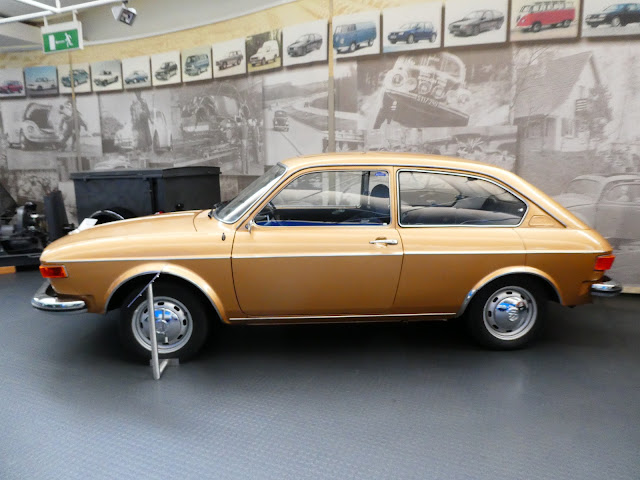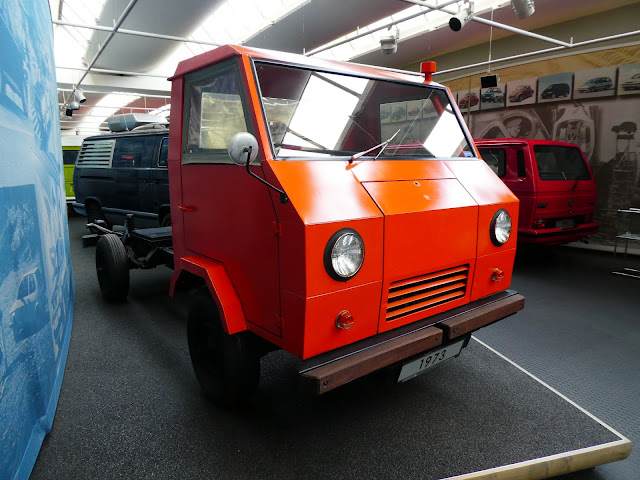The museum's treatment of the early years of Volkswagen is sketchy at best. The entire period of the car's development, which of course took place as a Nazi project, is skimmed through. Ferdinand and Ferry Porsche's contribution, so fundamental to the company's history, is given very short shrift. Nor were there any of the company's early cars and reproductions on display. Instead the beetle, one of the world's most important motorcars, is introduced with a lackluster line up of a post-war split, an oval window and a Super Bug. That's it. The information sheets on each car were also spartan and uninteresting. This was the Tatra Museum over again.
The Karmann Ghia and coach-built display was also meagre and lifeless, again presented without any historical context. It was only when the display gets to the modern era of the Golf and the many interesting prototypes Volkswagen experimented with in the 1960s and 70s was there any sense of enthusiasm. Perhaps the company feels it is on safer ground here.
Finally, what does any good museum need? A giftshop. As disappointed as I was I would still have browsed through the books and memorabilia, but no. There was only a small display window and postcard stand beside the ticket desk. http://automuseum.volkswagen.de/en/the-museum.html
But although the AutoMuseum collection was disappointing, Volkswagen has a second museum in Wolfsburg, the Zeithaus within the Autostadt complext and that is an entirely different story....

A modern Volkswagen concept car opens the collection.

Where it begins .... and it could not be more disappointing. Is this really the best that Volkswagen can do to showcase the development of one of the world's most important motor vehicles.

Volkswagen Beetle row

Karmann cabriolet. Volkswagen outsourced construction of the cabriolet model to Karmann Karosserie of Osnabruck. Karmann had pioneered the folding cabriolet top in the 1930s and went on to build cabriolet models for dozens of companies, but the Volkswagen contract came to dominate the company. They built VW cabriolet's until the beetle was withdrawn, plus the two Karmann Ghia models, Porsche 356s and 911s, and even Type 4 campervans. The company eventually went bankrupt in 2009 and was swallowed up by the Volkswagen Group.

Volkswagen cabriolets

Hebmuller four door police kubel

1953 Hebmuller four door taxi. Hebmuller was another independent karosseriewerkes that manufactured variant bodies for Volkswagen. In 1949 they were contracted to build a neat two seater roadster version of the beetle but went bankrupt after only 696 were built. Hebmuller also built a four door taxi beetle.

Volkswagen coachbuilts -Dannerhausen and Stauss, Ghia Aigle and Rometsch.

Rometsch Lawrence

1956 Volkswagen Ghia Aigle

1951 Dannenhauer und Stauss. The Dannenhauer and Stauss karosseriewerkes began fitting these neat custom roadster bodies onto Volkswagen beetle running gear. Each car was handmade; the panels being handbeaten onto the frame, consequently they were an expensive vehicle at three times the price of a standard beetle. About 100 cars were built before the arrival of the VW Karmann Ghia in 1957 put them out of business.

Volkswagen Karmann Ghia's - and that's it. Nothing explained.

1955 Volkswagen EA 47-12 prototype

By the mid 1950s Volkswagen began to investigate modernizing and replacing the beetle. The Italian carosserie Ghia, who had just styled the beautiful Karmann Ghia for Volkswagen, developed the concept into a four seater sedan. Fifteen cars were built but Volkswagen decided to continue with the beetle.

The military section - 1944 Schwimwagen and military kommanderwagen

1944 Kubelwagen, the ubiquitous German 'jeep' of the Second World War. It served on all fronts with distinction.

The Puma sportscar was built in Brazil on a Volkswagen beetle running gear. Puma's had originally been built on DKW-Vemag running gear until Volkswagen purchased Auto-Union in 1965.

Brazilian Volkswagen SP2

Volkswagen SP2

Volkswagen Type Variant

Late model 1966 Type 3 411 variant from South America

1973 Volkswagen 412 Variant

Volkswagen Type 2 transporters. The iconic Type 2 bus was put to so many different uses but it is colloquially known everywhere as the 'kombi.'

A Volkswagen utility and Samba bus


Fridolen van

1973 four door K 70 L sedan prototype (likely based on an Audi or NSU design)

1973 Volkswagen Scirocco I

1972 Volkswagen Passat

2003 Volkswagen W12 Coupe

Volkswagen XL1 electric concept vehicle and the Volkswagen 1 Litre trial vehicle

1963 Volkswagen EA 128 prototype. This large four door sedan was intended for the US market, hence its substantial proportions. The car was powered by a six cylinder Porsche boxer engine from the 911.

Volkswagen Golf, the car that saved Volkswagen.

This 1976 concept vehicle is built over a very early beetle running gear. Seems a bit of a waste to me....
Some more links: https://www.hemmings.com/blog/2016/10/11/a-tour-of-vws-other-museum-in-wolfsburg-the-stiftung-automuseum-volkswagen/